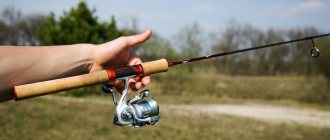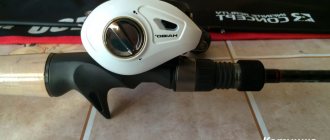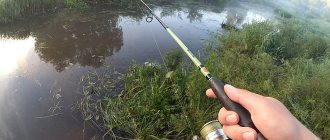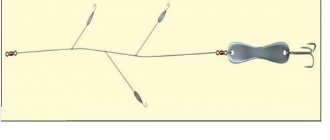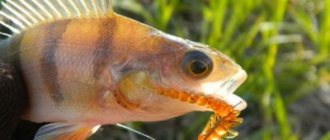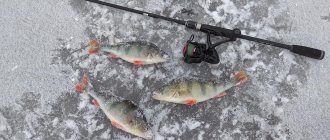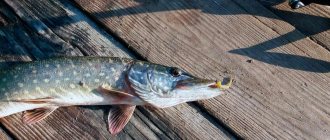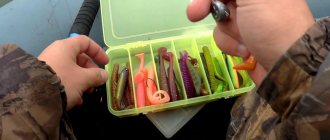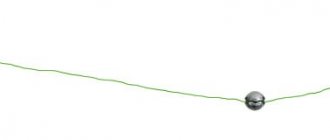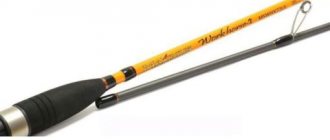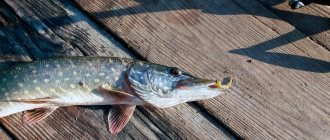The jig spinning rod showed itself as an independent tackle somewhere at the end of the 20th century. Presumably, it got its name from the name of the dance of the same name. A characteristic feature of this method is an uneven, stepped or “dancing” manner of wiring, and the types of baits used can be very different, but the main ones are distinguished by the presence of a mandatory weighting of the bow.
Accordingly, this technique is used everywhere: in deep holes, shallow water and sand spits, and even in wetlands by installing offsets or special surface baits. Any predatory fish can be caught, but especially good results are achieved when hunting pike, perch, pike perch, and asp.
Initially, it was understood that jig fishing consisted exclusively of stepped wiring, i.e. The bait should always touch the bottom periodically. This is due to the characteristics of the most popular baits, the order of appearance of which on the market of our country can be divided in ascending order:
- Tackle with dead fish. This method goes back a long way, since this is the only way to most plausibly imitate a living inhabitant of the underwater world in the absence of flexible materials.
- Foam fish. This method appeared, accordingly, with the beginning of the use of foam sheets in furniture production. Fishermen cut out their own fish, painted them, and added aromatic drops. Some even managed to make vibrating tails.
- Turntables with a weighted nose. In general, initially this trick was used to make long-distance casts, since spinning rods until the 80s simply did not allow working with light bait. And only recently it became clear that the use of jig technology with such spoons shows good results.
- Silicone baits. Recently, there are a huge variety of them, in a variety of colors and shapes. It is they that today are identified by novice fishermen with the term “jig”.
A separate area in fishing practice is the use of poppers and walkers. They cannot be clearly classified as traditional jigs. But the manner of retrieving, including intensive play with the rod, may well claim a very close relationship. Moreover, the use of these baits allows you to expand the fishing area and hunt in places where even an offset fish has a huge chance of being left in the grass. These are wetlands and very shallow waters where fish come out to bask in the summer.
All this variety of baits imposes certain requirements on the equipment of fishing gear, depending on how, where and what will be hunted. The main thing to start with when equipping a spinning rod for jigging is choosing a fishing rod.
Parameters that play a decisive role when choosing a fishing rod
Every professional spinning fisherman has in his arsenal not one, but a whole set of rods, each for a specific purpose. Until the 80s, it was difficult to find suitable tackle, since there was a huge shortage of light and durable materials. But the situation changed dramatically after the appearance of fiberglass on the market, followed by carbon fiber and composite materials, which made it possible to assemble fishing rods with a wide variety of parameters and prices.
Here are the main characteristics that allow you to create a set of spinning rods and suitable baits:
- Material. Its diversity makes even experienced fishermen confused, but two favorites remain the leading ones here - fiberglass and carbon. The first one is cheaper, but worse in such parameters as strength and lightness. And in jig fishing, and spinning fishing in general, this is important. Because not only do you often have to cover considerable distances on foot, but you also need to fish promising places several times. Therefore, only carbon fiber should be considered. Moreover, the principle “more expensive is better” does not play a role here.
- Rod test. This parameter is very important, since it depends on the weight category in which you are completing the set of baits. And this, in turn, is determined by which body of water and what kind of fish you will catch. For example, when fishing for a large predator, such as pike or even catfish, on a large river and the presence of a strong current, you need to use a rigid rod capable of casting a heavy jig weighing from 40 to 120 grams. Small rivers where medium-sized predators are found (pike, pike perch, asp, perch) are suitable for a widely used option for medium jigs with a dough of 15 to 40 grams. Pools, backwaters and small lakes are characterized by the presence of inhabitants weighing up to 3 kg, usually pike and perch. Light tackle with a dough of 8 - 15 grams is ideal here. Well, in the case of catching fish such as perch in small reservoirs, you should use an ultralight type rod for microjigging with a test weight of up to 5 grams.
- Build. There are three types, fast, medium or semi-parabolic, and slow or parabolic. Each of them sets the bending shape of the rod when a characteristic load is placed on it (for example, asking for bait or landing fish). It is better to start the description with a slow build, because... Recently, it has become fashionable among spinning anglers to use this type, since it is precisely this type that is characteristic of the so-called ultralight with a test of 3-8 grams. The reason for this popularity is that even with a small catch, the spinning rod bends into a parabola, allowing you to fully enjoy the process. Among the obvious features we can also highlight the use of thin lines due to the soft blank. Fast action is typical for rigid rods with a weight of 40 grams or more, where only the upper part of the blank is involved in shock absorption. The use of such gear will be effective, for example, when trolling or for quickly pulling fish out of the water, which is typical for sport fishing. Due to the main drawback - the short casting range - fast action forms have not gained wide popularity among amateur fishermen. The favorite is occupied by the semi-parabolic or medium tuning, which combines all the best from the two types described above. Thanks to the optimal combination of all parameters, such a rod can cast baits in a wide range. Ultimately, when choosing gear, you need to clearly understand the purpose of fishing and be guided by the parameters marked on the form. It should be remembered that the sensitivity of the tip (whip) directly depends on the action; the stiffer the rod, the clearer the connection with the other end of the fishing line will be. A soft blank will dampen jerks, introducing unnecessary inertia.
- Length and weight of the rod. The size of the blank affects, first of all, the casting distance. The sizes of spinning rods range from 1.5 to 3 meters, from which you can understand that the average or, as it is called, universal length is 2.2-2.4 meters, which is often chosen by beginners. But with increasing skill, the fisherman begins to select gear that is more suitable for fishing conditions. Thus, fishing from the shore in large bodies of water is characterized by the need for long casting and the absence of snags on coastal vegetation. Therefore, the optimal length here would be 2.7-3 meters. From a boat, long-distance casting is not so necessary, until the implementation of vertical lure fishing. Then choose sizes not exceeding 2.1 meters. However, when fishing on small rivers with densely overgrown banks, it is simply impossible to work with a long rod and use a “short” one up to 1.7 meters. The weight of the rod is directly proportional to the length and type of material from which the spinning rod is made. A fiberglass blank will be significantly heavier than a carbon blank, whose weight with a length of 2.1 meters does not exceed 150 grams. However, weight is not a determining factor; the balance of the rod is very important, which determines how quickly the hand and arm get tired during multiple casts. The center of gravity of the equipped spinning rod should be at the place where the reel is attached.
- Construction type. Spinning rods, like any other, can be divided into two types: plug-in and telescopic. The first option is characterized by 2-3 knees, connecting one into the other. They have excellent reliability, strength, low weight, but the disadvantage is their large length when folded. The second type does not have this problem, since it has a large number of sections. But at the same time it is distinguished by greater (2-3 times) mass and low reliability. In general, there is a general rule - the more joints, the more the strength of the structure suffers. When choosing any form, you simply need to pay close attention to the quality of the connections.
All recommendations for choosing a fishing rod can be summarized and a few tips can be given. The quality of workmanship must be checked immediately; the product must pass a simple test. To do this, you need to position the rod in the line of sight and make sure that the blank has no longitudinal defects, and the rings are on the same axis with the reel lock. The latch itself needs to be checked by installing a coil in it and determining that it is securely fastened.
It’s easy to check the rod’s structure for compliance with the stated parameters by resting the tip of the whip against the wall under the ceiling, so that 2/3 of the length of the blank remains free. Create a slight longitudinal tension by pressing forward - the tackle will take on a shape that matches the action. Be careful as excessive force may damage the whip. Accordingly, before the test you need to make sure there are no cracks or chips.
You can also give examples of rods used in different situations that will allow novice anglers to make their first choice:
- A universal spinning rod model that is suitable for fishing in standing waters from the shore or from a boat, as well as on all types of rivers. The characteristic length of such gear is from 1.8 to 2.4 meters, the action is average, the test should be in the range of 10-40 grams. An example is the plug-in Daiwa “Sweepfire” SW802LFS-BD jigger 2.4m with a test of 5-25g and medium action.
- Fishing from the shore in large bodies of water involves the use of a rod with a length of 2.7 to 3 meters with a fast action and tests in the range from 7 to 45 grams. This spinning rod allows you to cast with a wide variety of baits. When choosing such equipment, you should take a closer look at the spinning rods from the Black Hole Hyper line.
- When fishing from a boat, it is recommended to use spinning rods “in height”, i.e. from 1.5 to 2.1 meters. The system used is fast, and the test ranges from 10 to 40 grams. To choose a fishing rod from this range, you need to pay attention to manufacturers Daiwa, Shimano or the domestic Volzhanka. By the way, Volzhanka spinning rods are quite affordable, but quite reliable and have a wide range of parameters.
Criteria for choosing a spinning rod
Like any fishing rod, special criteria will help us choose a spinning rod for jigging:
Build
The most important characteristic of a jig rod. Construction is not as simple a concept as it seems at first glance. For us, action means the reaction of the rod to the load. Visually, we can see this by the bend. What kind of action should a jig spinning rod have?
The ideal option is a fast or super-fast action. And here’s why - spinning rods marked fast and extra fast have characteristics that are important in our case. These are sensitivity, power and casting accuracy.
Length
In a situation with length, you need to choose taking into account future fishing conditions. The length will depend on the type of reservoir. A big river will require a long rod. In order to be able to throw to the desired point: 2.4 - 2.7 m is the optimal growth range for a large river.
For fishing from a boat in a large area of the reservoir, you can use 2.7 m, but it is better to limit yourself to a blank of 2.4 m.
In the cramped conditions of a small river and micro-river, we need a short spinning rod up to 2.1 m. With it, it’s convenient to make our way along the overgrown bank and we don’t need to cast far. This length is quite enough.
Form material
The composition of the material from which the blank is made directly affects two parameters that are important in choosing a spinning rod for jigging. Any fishing rod can be made of three materials: fiberglass, carbon fiber (graphite) and composite. The best thing to do in jig fishing is to use a carbon fiber rod. It is usually marked with indices: IM6 - IM9. It is believed that the higher the numerical value, the more sensitive it will be. But a carbon fiber rod has a significant drawback - fragility. Manufacturers compensate for this by adding fiberglass to the material to increase strength.
It was the composite that appeared with the aim of increasing strength and reducing the cost of production. Yes, the composite has less sensitivity, but there are conditions when sensitivity is not the main parameter. The power and accuracy of casting play a decisive role on micro rivers, for example. Let me explain.
When the depths do not exceed two or three meters, the weight of the load is only a few grams. And we fish with a powerful rod, with a weight of up to 30 grams. and even the most sophisticated carbon fiber “stick” will not allow us to feel the bottom. In such a situation, the best thing to do is to use a budget option made of composite material.
Accessories
Rings, reel seat - the component is not so important, but still, you need to look at it. The problem of sawing through the rings has long since disappeared. Today, even the simplest spinning rod has rings that the braid does not take. Of course, if this is not outright China under the “Yun” brand.
The reel seat deserves more attention. The current trend is handles with a minimum of EVA at the very end and in the area of the reel seat. Thanks to this, it becomes lighter and more convenient.
Choosing a reel for installation on a jig spinning rod
When assembling gear, you should always remember that there is no such thing as an unimportant detail. This statement also applies to the choice of reel. They come in three types - inertia-free, inertial and multiplier. It is difficult to say which type to give preference to, since, as in the case of a fishing rod, you need to navigate based on the requirements for fishing conditions.
- A spinning reel in a jig tackle. Due to ease of use and reliability, this type of reel has earned enormous popularity among anglers. When choosing, first of all, you should pay attention to the assembly quality of the arch elements: the laying roller must have a bearing in its design to avoid the formation of cuts on it by the fishing line, and is also protected by a special coating (for example, titanium). It is desirable that the bobbin of the reel also have such protection. It is necessary to have an instantaneous stopper mechanism for the overrunning clutch, which allows you to save the moving elements of the reel from wear when catching a large specimen, taking on the entire load. An endless screw system is used to lay the fishing line turn to turn. As in the case of fishing rods, the leading manufacturers are Daiwa and Shimano (DaiwaTD-SOL, Team Daiwa Advantage 4000, DaiwaCertate Hyper Custom 3000, Shimano Stella 4000, Shimano Twin Power 4000 PG).
- Inertial reels and multipliers in jig fishing, generally speaking, do not have any superiority over inertialess ones, since they are very difficult to use and have a number of disadvantages, such as a high probability of the formation of a “beard” when casting and the lack of auxiliary elements when landing fish. Of course, there are advanced designs, but they do not provide a 100% guarantee against line tangling and cost the same as their high-quality competitor. Therefore, this type of gear is used rather for aesthetic pleasure, taking the fisherman back to the times when Nevskaya type reels were the most popular.
We recommend reading: Tying a Gardner loop for feeder fishing
The first spinning rod and the fish caught on it
After the above, it becomes clear that a novice fisherman needs a spinning rod with a length of 2.4-2.7 meters, a test weight of 10-40 grams, a semi-parabolic or fast action with a lightweight spinning reel from recommended companies installed on it. Although it is tempting to use braided line, beginners are still advised to choose 0.25mm monofilament line. Braid, despite its strength, is very capricious and requires certain skills in handling. Based on the diameter, you need to choose the volume of the spool - the capacity must be at least 100 meters, this can be determined by reading the information on the side of the bobbin (this is indicated - 0.25 - 100 m).
When your spinning rod is assembled, install a retractable leash and a carabiner with a swivel, be sure to alternate the use of baits while fishing. Start with twisters and spinners, as using them requires minimal skills. Focus on pike or perch; these predators weighing up to 1 kg are unpretentious, they are completely indiscriminate, so they are ideal for practice. You should look for them in snags and thickets of coastal vegetation, as well as in whirlpools, streams descending from shallow water to depth and near any obstacles where a predator can organize a shelter for itself. Fishing in such places is quite difficult, so carefully examine the visible topography of the bottom and try to predict how it will behave in the part inaccessible to view.
Wiring should be done along obstacles, avoiding the bait getting into the snag itself or the grass. Moreover, the predator often attacks the bait not in the line of sight, but from behind cover when it begins to hide from him. There is even a tricky way: if you see that a predator is chasing the bait, near the shore, when the rod allows it, turn it 90 degrees relative to the initial movement. Predatory fish reflexively attacks the bait. You shouldn’t stop at one place either; spinning fishing in itself is a sport. To catch a predator, you need to look for it. It is better to practice the casting technique in open areas; master the overhead, side and pendulum casting - this will be enough to fish in all the places you like in the future.
Jig spinning test
Traditionally it is indicated on the form in grams. The indicated figures indicate the possible weight of baits that are most optimal for use in conjunction with the fishing rod in question. In most cases, the possible load on the fishing line or cord used with this fishing rod is also indicated.
Let's look at spinning rods for common fish species:
Perch. A light jig spinning rod with a bait weight of up to 10 g for fishing in good conditions (without grass and snags) or a heavy version of up to 15 g for fishing in more difficult conditions is best suited.
Pike. The light version is a jig spinning rod with an indicator of 15-20 g (for catching pike up to 1 kg or when the area of the reservoir is clean), and the heavy one is 20-30 g for catching medium and large specimens or when fishing in difficult conditions.
Zander. A light spinning rod with a weight of 20 g for catching small pike perch up to 1 kg or a heavy version (30-40 g) for catching deep-sea pike perch weighing from 1 kg.
Rating of the best jig forms
Here and further it should be said that telescopic rods are not included in the rating; only reliable plug-in designs are considered. So, the rating of jig spinning rods:
- Kosadaka Rover Jig Special 270 is a two-section representative of the budget line of fast action jig blanks. With a length of 2.7 m and a test weight of 10-35 grams, this rod allows you to work with any bait, such as foam fish or silicone baits. Price 2565 rubles.
- Banax Mega MC90MHF2 is a two-piece high sensitivity rod using Fuji guide fittings. It has a fast action, ensuring accurate casting and powerful hooking. There are modifications for both casting and spinning. Length 2.74 m, test 7-35 grams. Price 3000 rubles.
- Daiwa Neoversal 762MLFS is a pleasantly surprising two-piece new product, focused on the principle of versatility and reasonable price. Length is 2.29 m, test 5-21 grams, weight 165 grams. Excellent for trout and perch fishing. Price 4443 rubles.
- Banax TinFish 80MF2 is a universal rod with a length of 244, fast action and a cast of 7-28 grams, ideal for beginners, equipped with Fuji fittings. The average market price is 5000 rubles.
- Pontoon 21 Gad Harrier 702MHF, length 2.13 m, test 12-45 grams, transport length 0.11 m, two sections, parabolic action, Fuji IPS coil clamp, Fuji rings, very low weight - 118 grams, price is 5330 rubles .
- Aiko Asgard JIG is a whole line of new jig rods. There are a variety of models at a variety of prices. For example, ASG 742L has a length of 2.24 m and a test of 3-14 grams. Classic fast action, fishing targets include chub, catfish, perch, pike and pike perch. The price will be 7600 rubles.
- Norstream Spiker 782MH is a two-section hard spinning rod with a length of 234 cm, a test weight of 10-35 grams, designed for twitching with bulk wobblers. When folded, it will take 120 cm, the price is 8200 rubles.
- Crazy Fish Perfect Jig CFPJ-76-LT is a characteristic two-section representative of fast action jig equipment with a length of 2.3 m with a dough of 3-15 grams. Thanks to its light weight of 107.4 grams and its long range, it allows you to comfortably spend long periods of time fishing. Price 8528 rubles.
- Pontoon21 Psychogun 912MMHSF is a long-range two-section rod from an extensive line, 2.77 meters long, perfect for light jigging and complex gear, and has a test weight of 10.5-32 grams. Made from Torey carbon fiber using Fuji fittings. The price ranges from 8500 to 9000 rubles.
- Norstream Partner 70H, two-piece rod, 213 cm long, fast action, 15-45 grams. Specially designed for jig fishing from floating craft, allowing for unusually long casts. The design is very informative about the contact of the bait with the bottom. Folded length 109 cm. Price 9600 rub.
- Pontoon 21 Detonada is a whole line of casting rods, combining both long-range and boat models. High-quality carbon fiber, Fuji fittings – all this distinguishes the forms of this series in the price category from 10,000 to 12,000 rubles.
- Daiko Ultimatum 962HMF is a two-section fishing gear with a fast action blank, which, with a length of 2.89 meters, allows you to work with jig baits in a wide range from 12 to 60 grams. The price will be 13,525 rubles.
- Major Craft Rizer 702H, a two-section rod 213 cm long, ultra-fast action with a test weight of 10-42 grams, was specially developed by Japanese engineers for jig fishing with all known lures. Rings and reel retainer from Fuji. Price 14100 rub.
- Major Craft Rizer 832MH is another two-section representative of the Rizer line from Japanese manufacturers, has a length of 250 cm and a weight of 150 grams, designed specifically for jig fishing with lures weighing from 8 to 35 grams. When folded, it is 130 cm long, the price is 14,755 rubles.
- Norstream Kando 902MH is an excellent two-section rod weighing 178 grams and a length of 274 cm, a unique rod specifically for jig fishing, informative in everything - from probing the bottom topography to the slightest bite. Thanks to its design, it allows you to cut even the most sluggish specimens, has a test weight of 10-38 grams and a folded length of 144 cm. Price: 15,320 rubles.
- The Graphiteleader Tiro 792ML is a two-piece rod with a length of 2.36 meters, distinguished by its unique action, which allows you to get a smooth casting plateau when using lures in the range from 4 to 22 grams. All this makes it ideal for both jigging and twitching. The price is 24,000 rubles.
- The Graphiteleader Finezza Trenta 2-section spinning rod with a length of 2.37 cm will delight you with its performance when catching small perch, pike, chub and especially trout, allowing you to use bait weighing 0.6-10 grams. Fuji fittings are used. Price 27195 rubles.
Budget line of jig rods
- Banax Thunder 90MXF2 is a Korean representative of two-section fast action jig rods with a length of 2.13 m. Equipped with Fuji rings, it has a good test of 7-25 grams. It is, in fact, a universal fishing rod that is suitable for beginner anglers. Price 6500 rubles.
- Black Hole Hyper III is an aggressive spinning rod with fast action for fishing with jig baits. Length 2.7 m and test 8-28 grams. Equipped with Fuji fittings that have an anti-flood system. Stylish and bright design for only 8,000 rubles.
- Maximus High Energy X is a representative of reliable fast action rods with a length of 2.7 m and a test weight of 5-20 grams. Equipped with a ring system with Sic inserts. It has a small weight of 154 grams and a transport length of 140 cm. The price is 4,500 rubles.
- Maximus Black Widow is a whole line of jig spinning rods in the price range from 5,000 to 7,000 rubles. Among them, the angler will find one that will satisfy any request. A great option if you want to start collecting a set for different types of fishing.
- Norstream Element 832ML is an excellent two-piece jig rod with a length of 2.51 m (folded 0.13 m) with a fast action and a cast of 5-23 grams. The price will be almost 9,000 rubles.
- Shimano Catana CX 210 UL is an ultra-light two-piece fast action rod with a length of 2.1 m and a weight of 1-11 grams, ideal for trout fishing on small rivers. When folded, it will take a little more than a meter, and the price is very affordable - 2900 rubles.
- Micromania MMJS-702UL is an ultra-light spinning rod with a length of 2.13 m and a dough of 0.8-7 grams, suitable for fishing with the most weightless baits. The cost is 7300 rubles.
- Salmo ELITE JIG is a special fast-action jig spinning rod made of carbon fiber, 2.43 m long and with a dough of 5-18 grams. Fitted with rings with SIC inserts, ultra-light and elegant. The price is only 2600 rubles.
- Salmo Diamond Jig is the most affordable plug-in jig spinning rod in the budget line in terms of price/quality ratio, 2.1 m long and with a dough of 3-15 grams. The price is 1800 rubles.
- Volzhanka “Jig” is an excellent solution for a beginning fisherman from a domestic manufacturer. The length of 2.1 meters and the test weight of 5-25 grams make this fast-action rod universal in use for catching fish such as pike, perch, pike perch and asp. The price does not exceed 2700 rubles.
Rod build
Action refers to the reaction of the rod to the load placed on it. Traditionally, a spinning rod is considered ultra-fast, when under load, a fourth of the upper leg bends. Fast spinning is the bend of the third part of the whip, medium is half, and slow is the bend of almost the entire spinning rod.
A jig spinning rod, first of all, must be extremely sensitive and loud, while professional opinions differ regarding the category of optimal action itself.
Jig rod length
The length of the rod depends on the future fishing conditions. However, if these conditions change, you can choose the optimal, most universal length. Of course, finding a spinning rod that meets all the desired parameters (brand, test, design) can be a difficult task, so sacrificing 10-20 cm in length will not be critical.
For fishing from a boat, the optimal rod length is 1.7-2.1 m. For coastal fishing, this figure becomes 2.4-2.7 m. The universal length, as you might guess, is 2.1-2.4 m You shouldn’t be too strict about the widespread opinion that a spinning rod of universal length cannot be good. It is the rod length indicated above that is the most common and has proven itself. Ideal especially for novice fishermen.
Rating of elite spinning rods for jigging
There are lines of elite fishing rods, some of which are presented below. Also, do not forget that a detailed review of fairly good forms was given above, in the ranking of the best, sorted by price.
- Graphiteleader VIVO 842M is a bright and eye-catching, as its name suggests, representative of fast-action spinning rods for jig fishing. Spinning rods under this brand were developed taking into account all the preferences of Russian fishermen, and are ideal for catching pike, pike-perch and perch. The length of the rod is 2.54 m, weight 127 grams, test 7-28 grams, and when folded the tackle will take 1.3 m. The price will be 27,025 rubles.
- St.Croix Legend XTreme LXS76MLXF2 is a reinforced, fast action rod with hand varnished finish and Fuji fittings. Length 2.28 m, test 3.5-10.5 grams, folded length 1.15 m. Price 28,225 rubles.
- Graphiteleader Rivolta. This line is designed to meet different fishing needs and offers rods of different lengths, power and test. Thus, models 772M, 772M are suitable for classic jigging, and 702M, 692ML for twitching. 732Le, 772L, 742L and 6112L are suitable as universal rods. The latter is ideal for fishing for trout, chub or perch. Long-range blanks 812H, 892MH, 902H will deliver heavy jig bait to any distance. The price of rods varies from 12,000 to 30,000 rubles.
The best spinning rods for jigging
Some companies produce special models designed for jig fishing . One of the best examples is the Black Hole Hyper . It was specially designed for jig fishing, and at the same time has a very low price.
high sensitivity at a relatively low cost .
Elite models include Shimano Game AR-C. This high-level spinning jig is used by experienced professionals.
There is even a Shimano Game AR-C model with 84 gram test.
Twitching and rods for it
This type of fishing has already been mentioned several times in the article with a detailed description of some fishing rods. Here it will be discussed in a little more detail. Twitching is a type of retrieval when fishing with a spinning rod, where, unlike the classic jig, the bait is brought in not by steps, but by various jerks or pull-ups. You can fish with any bait: popper, wobbler, walker, minnow wobbler and even silicone.
Recommended reading: Details about feeder fishing, necessary gear and some subtleties
Accordingly, the same fish are caught as with a jig spinning rod - any predator: perch, pike, asp, chub, pike perch, catfish. The main difference is that for twitching rods with fast or ultra-fast action are suitable, which are the most informative and allow you to hook as quickly as possible.
Description of some models:
- Surf Master YS5007 Yamato Series Kanagawa Twitch TX-30 is a two-section plug-in spinning rod for twitch, made in two variations, 2.05 m and 2.25 m long, and weighing 107 and 119 grams, respectively. Tests 3.5-11 grams for both, folded lengths 1.03 m and 1.13 m. Cost 5516 and 5821 rubles.
- Norstream Kando KDS-662L Technic Master is a rigid two-section fishing rod for catching chub, pike and even ide on small rivers. Great for twitching and light jigging. The length is 1.98 m, the test is 3-10 grams, the weight is 99 grams and when folded the rod takes up 1.08 m. The cost is 12,060 rubles.
- Shimano BEASTMASTER DX SPG 240 ML rigid fast action rod with a length of 2.4 m and a test weight of 7-21 grams, weight 145 grams, folded length 1.23 m. Designed for precise delivery of bait to any point in the reservoir and quick landing of fish without damage fishing line The price will range from 6,000 to 8,000 rubles in different stores.
Spinning rod length for jig
Now on sale there are spinning rods with a length of 1.6 m to 2.7 m, although spinning rods with a length of 1.6 m are narrowly directed spinning rods, so rods with a length of 2 to 2.7 m are considered the most common.
If you are going to fish with a jig, then buy a jig 2.3 m - 2.5 m, but the most optimal length will be 2.4 m. This length of the spinning rod allows you to make absolutely any retrieve, for example high blasts, with a shorter 2 meter with a fishing rod, such explosions will need to be done using your hands, while with a 2.4 m rod, working with a brush is enough. Long rods also increase casting distance and simplify the process of landing fish. It becomes much easier for you to circle a snag lying near the shore or prevent it from going into the thickets of reeds and water lilies.
There is an opinion that when fishing from a boat, it is better to use a short rod, and this is true in cases where the boat is small and you are also fishing together. If you fish yourself, or the watercraft is large, then it is also better to use a rod 2.4 m long, since this will allow you to make better fishing and you do not need to buy a separate rod.
The test of the chosen rod depends on the depth of the reservoir, the presence of current, the size of the bait and the casting distance.
Classification
- Ultralight has a test from 1 to 7-8 grams.
- Lat with dough up to 12 - 15 grams;
- Medium light with dough up to 20 grams;
- Medium test up to 30-40 grams;
- Heavy class test up to 60 grams;
Ultralight is used when fishing for perch in reservoirs up to 2-3 meters deep. In this case, we use light sinkers weighing up to 5 grams and small baits 2-2.5 inches. The main advantages of the rod are that it has maximum sensitivity and we can feel the resistance of even small bites, getting maximum pleasure from fishing. If you purposefully catch pike on this reservoir, then the jig spinning rod should be more powerful, at least light class, because if you put a bait 4 inches long, then only one bait will weigh about 5 grams. At the same time, you still need to have an additional margin of safety, since pike is a large and strong fish.
At the same time, light rods, complete with thin cords, allow you to place weights weighing 2-3 grams and also successfully catch perch.
Next, we choose a fishing rod depending on the depth of the reservoir or, if it is a river, the strength of the current. For example, fishing rods with a weight of up to 15-16 grams are suitable for jig fishing for pike perch at depths of up to 6-7 meters. If it is a river with a current, then you need to fish at shallower depths (4-5 m), or use heavier loads.
For fishing in reservoirs where depths can reach 10-12 meters, spinning rods with a test weight of up to 27-30 grams are used, and on rivers with moderate currents and great depths with a test weight of up to 30-40 grams. On large and powerful rivers you may need spinning rods with a test weight of 60 grams.
Before buying a fishing rod, it is advisable to consult with local fishermen about what baits and weights they use here and, based on the numbers mentioned, choose a spinning rod for jigging.
When buying a whole rod in a store, unfold it and try how it fits in your hand; spinning anglers have a concept where a rod doesn’t fit in your hand. It is also not recommended for beginners to immediately purchase top-end forms; it is better to start with budget or mid-priced versions, and when you get used to jig fishing and know what exactly you need, purchase more expensive models.
Using a nod when jigging
Surprisingly, even today, when, as we could see, the range of fishing rods can satisfy the most demanding buyer, anglers continue to modernize gear to achieve maximum catchability. One such device is a jig nod.
This simple homemade product allows you to make tackle from spinning rods with 10-30 grams of dough that will work perfectly on baits weighing 2-3 grams. There are several ways to make such a nod; the most popular is a fiberglass nod.
To make it you need:
- find the elbow from an old telescopic fishing rod and chop off a sliver with a sharp knife so that it is 30 cm long and 0.3 cm wide;
- carefully grind and polish the workpiece with sandpaper, first with coarse grain, then with “zero” sandpaper, eliminating the possibility of cracks and chips;
- place a tulip on the tip of the resulting whip and secure it using the classic method using electrical tape or thread with glue;
- The nod assembly is mounted to the upper tip of the rod using reinforced tape.
Using a similar method, you can expand the capabilities of a fishing rod using a spring made of fishing line or metal, a rod from a feeder, etc.
We equip lures for jig fishing
There are several basic methods for equipping jig baits, which can be presented as a list:
- Jig head. This rig consists of a lead sinker with a hook soldered into it. A silicone bait (vibrotail, fish, frog, etc.) is put on the hook, starting from the head part, so that the hook extends slightly beyond the middle of the bait’s body. From here the length of the hook is selected. That is, if the hook is 4 cm long, then a 6-centimeter fish should be put on it.
- Cheburashka. The difference from the method described above is that the sinker has two large ears (hence the resemblance to a cartoon character) and the bait on the tackle is attached to the hook through a winding ring. This configuration gives an additional degree of freedom when playing with bait. Offset mounting assumes that the hook will be hidden in the body of the bait, preventing hooks.
- Silicone without weight. Nonsense, but even this fishing method has its place. It is used mainly for microjigging, but there is an opinion that it appeared during a difficult time when there was no weight.
- Drop shot. This method probably originated from the “tyrant” tackle, where the sinker is located at the very end of the fishing line, and an artificial bait is attached above it. The difference is that a leash is not used, the hook with silicone is tied to the main fishing line.
- If you still use a leash in the method above, you get the so-called Moscow rig. It is noteworthy that for the first time such fishing gear, called “tyrant,” was used in sea fishing, and not in Moscow. The bait then was pieces of metal or bright rags, and later plastic, foam rubber and silicone.
- Texas rig. It consists of adding a sliding sinker to an unweighted bait. This also includes the Carolina rig, which differs from the Texas rig in the presence of a leash.
Wires used when fishing with a jig spinning rod
Stepped wiring
This method is the main one; any description of jig fishing begins with it. It is so universal that in addition to predators, it attracts even such lazy representatives of reservoirs as crucian carp. The technique itself may vary from place to place, but the basic steps are as follows:
- after casting, the bait is given time to touch the bottom of the reservoir;
- reel in the fishing line 3 turns, lifting the bait from the bottom;
- after the bait has touched the bottom again, repeat the second step.
The mass of the sinker is determined in accordance with the depth of the reservoir, the presence of a current and its speed.
The types of wiring include ultra-slow stepped and short. In the first case, the weight of the sinker and the speed are reduced as much as possible, which makes it possible to seduce a passive pike perch or sluggish perch. In the second case, winding is done by one turn of the handle instead of three. They try such wiring in completely “dead” moments, and if it turns out to be completely ineffective, it means that jig fishing is generally impractical at the moment.
American wiring
As in life, the wiring, called American, is very similar to the classic one, which was described above and is called Russian. But, of course, not without differences. With this tactic, almost all inhabitants of the reservoir are also caught, but it shows particularly positive results when catching pike perch:
- after casting, the bait is given time to touch the bottom of the reservoir;
- up and sideways smoothly, but quickly enough, pull the fishing line no more than two meters;
- reel in the excess using a reel, wait for the bait to touch the bottom again;
- repeat the second step.
A variation of the American technique can be called demolition fishing, where the second step is different in that the bait is not pulled up, but thrown up with a sharp swing of the rod, and in the third step the line is not reeled in while it is still possible to manipulate the bait. If you reel in the fishing line, this method is called aggressive retrieving. Such techniques are good at angering pike perch, pike and perch, provoking their attack with the sharpness of the retrieve.
Uniform wiring
Oddly enough, in some cases, such as night fishing for pike perch, you simply need to evenly move the bait in the middle layers of the water column. Here you just need to choose the bait well so that it “plays” at low speeds. A twister is perfect. If wiring needs to be done at the bottom, it is necessary not to reduce the speed, but to select a sinker.
Pendulum game
The targets with this fishing method are the same perch, pike perch and pike. The advantage is that you can fish heavily snagged areas, reducing the number of hooks to a minimum. Is as follows:
- after casting, the bait is given time to touch the bottom of the reservoir;
- the spinning rod is brought to a horizontal position and the tip of the rod is pulled up 15 cm;
- the tip is tactfully lowered, and after that the excess fishing line is reeled in;
- after the bait has touched the bottom again, repeat the second step.
Dotted wiring
It’s rare that a spinning fisherman can say that he didn’t want to catch an asp. This is the method that will allow you to do this, especially since, despite its complexity, it is very effective. Best used with Carolina rigs. Similar to the American one, only the suspenders must be made short, 20 cm up and to the side, ensuring that the sinker often touches the bottom, as if tapping it. Twisters are the best bait to use.
Blitz tips for choosing a spinning rod for jigging
There are a few things to consider before purchasing a jig rod:
- The build must be fast.
- The length of the rod depends on the fishing conditions (for the shore 2.7 - 3.5 m, for a boat 2.1 - 2.4 m).
- Ultralight spinning rods are suitable for jigging.
- Casting (test) should range within this range from 0.5 to 10 g.
If you are a beginner and find it difficult to decide on the choice of spinning rod for jigging, then it is best to have two rods in your arsenal:
- perch up to 10-15 g (upper test);
- for pike perch and pike 25-40 g (upper test).
But it’s worth paying attention to the fact that there are no templates in fishing. Therefore, all recommendations are universal. The choice of spinning rod depends on many factors:
- from the place of fishing;
- fishing conditions (from the shore or from a boat)
- baits;
- fish weight;
- characteristics of fish (perch, pike, pike perch);
- experience and preferences of the fisherman.
The choice must be made directly by you, taking into account all the necessary parameters and factors. Happy fishing!
